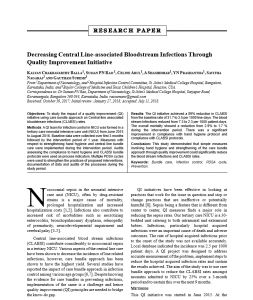
Nosocomial sepsis in the neonatal intensive care unit (NICU), often by drug-resistant strains is a major cause of mortality, prolonged hospitalization and increased hospitalization costs. Infections also contribute to increased risk of morbidities such as necrotizing enterocolitis, bronchopulmonary dysplasia, retinopathy of prematurity, neurodevelopmental impairment and cerebral palsy.
Central line-associated blood stream infections (CLABSI) contribute considerably to nosocomial sepsis in a tertiary NICU. Various aspects of the central line care have been shown to decrease the incidence of line related infections, however, care bundle approach has been shown to have the highest yield. Several studies have reported the impact of care bundle approach in infection control among various age groups. Despite knowing the evidence for care bundles in preventing infections, implementation of the same is a challenge and hence quality improvement (QI) principles are needed to bridge the know-do gap.
QI initiatives have been effective in looking at practices that work for the issue in question and stop or change practices that are ineffective or potentially harmful. Sepsis being a feature that is different from center to center, QI measures finds a major role in reducing the sepsis rates. Our tertiary care NICU is a 30bedded unit catering to both intramural and extramural babies. Infections, particularly hospital acquired infections were an important cause of death and adverse outcomes. The rate of hospital acquired infections prior to the onset of the study was not available accurately. Local database indicated the incidence was 2.5 per 1000 patient days. A QI project was designed to address accurate measurement of the problem, implement steps to reduce the hospital acquired infection rates and sustain the results achieved. The aim of the study was to use care bundle approach to reduce the CLABSI rates amongst neonates admitted to NICU by 25% over a 3-month period and to sustain this over the next 9 months.
—
This special issue of Indian Pediatrics (September 2018; Volume 55: Number 9) highlights mechanisms that can support health care providers in using various quality improvement (QI) approaches and showcases some of the improvement projects undertaken in India by different teams.
The USAID ASSIST Project started working in India in September 2013; initially working directly with districts and facilities to help them learn how to use QI approaches to save lives. This work went well and the staff in these facilities were able to reduce perinatal mortality by 15% over 18 months. During this time, we met great partners from important organizations and institutions across India.
These institutions are now leading a growing movement to help more people apply QI methods to deliver care that prevents harm, improves outcomes, and meets the needs of the people receiving it through their own networks using domestic funding; continuing these lifesaving efforts after ASSIST technical support has ended.
The supplement shows important results of the ongoing QI work in these networks and shows how domestic QI networks, earlier supported by ASSIST, are now independently supporting and spreading the use of QI methods to provide better care.